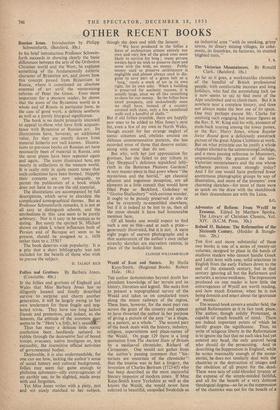Follies and Grottoes. By Barbara Jones. (Constable. 40s.) IF the
follies and grottoes of England and Wales that Miss Barbara Jones has so diligently located and fondly 'described survive to surprise and charm another generation, it will be largely owing to her own tenderness for these fragile and neg- lected trivia. They have too long lacked friends and protectors, and indeed, as she laments, the attitude of the commonaan seems to be "Here's a folly, let's smasHW."
Thus has many a delicate little scenic confection been heedlessly reduced to rubble through the destructive lust of bored troops, evacuees, native hooligans or, less excusably, the insensitive official activities of governmental bodies.
Deplorable, it is also understandable, for one can see how, lacking the author's sense of social history and cultural background, follies may seem fair game enough to philistine saboteurs—silly extravagancies of no earthly use, to be slighted, made away with and forgotten.
Yet Miss Jones writes with a piety, zest and wit nicely matched to her subject, thbugh she does end with the lament: We have produced in the follies a
form of architecture almost entirely our own and very few of the good ones seem likely to survive for long ; many private owners have no wish to preserve them and some with the wish, no money. Public money used to preserve architecture is negligible and almost always used in dis- guise to save part of a green belt or a ' lung,' rarely a work of art ip its own right, for its own sake. When a building is preserved for aesthetic reasons, it is usually large, since we all like something to show for our money. So the follies have small prospects, and undoubtedly soon we shall have, instead of a country covered with them, only a few castellated walls and a handful of shells."
But if old follies crumble, there are happily new ones to be added to Miss Jones's next list, even a few of my own in North Wales, though except for her strange neglect of scenic columns and, obelisks erected on dubious commemorative pretexts, she has recorded most of those that deserve notice, along with some that do not.
But why, with her just appreciation for grottoes, has she failed to pay tribute to Guy Sheppard's delicious sepulchral laby- rinth in the Battersea Pleasure Gardens? A very master-piece in that genre where 'the mysterious and the horrid," apt classical allusion and ingenious deception, are all elements in a little conceit that would have filled Pope or Beckford, Goledney or "Grotto Shaftesbury" with envious wonder. It ought to be piously preserved in situ or else be reverently re-assembled elsewhere, but if it is indeed to be lost to us, then all the more should it have had honourable mention here.
Of all books one would expect to find such a one as this—and at such a price— generously illustrated, but it is not. A mere eight pages of uneven photographs and a thin scatteration of the author's own rather scratchy sketches are starvation rations, in place of the looked-for feast.
CLOUGH WILLIAMS-ELLIS










































 Previous page
Previous page